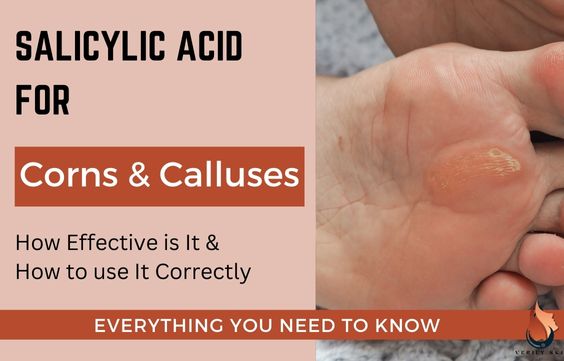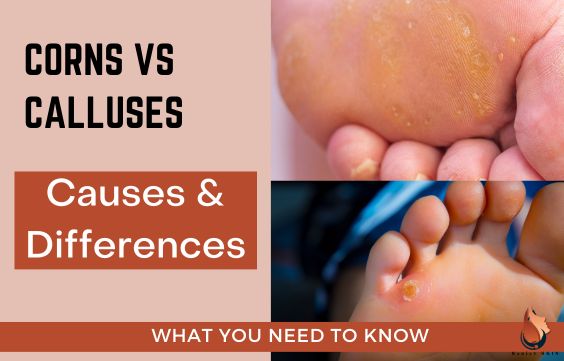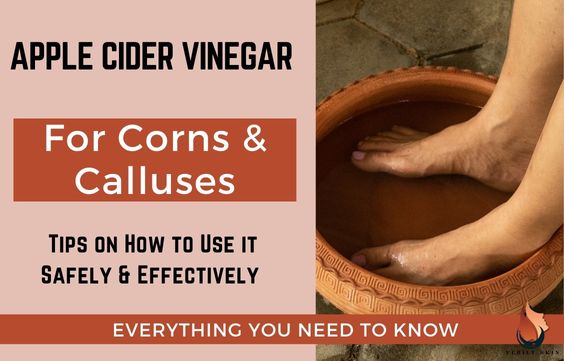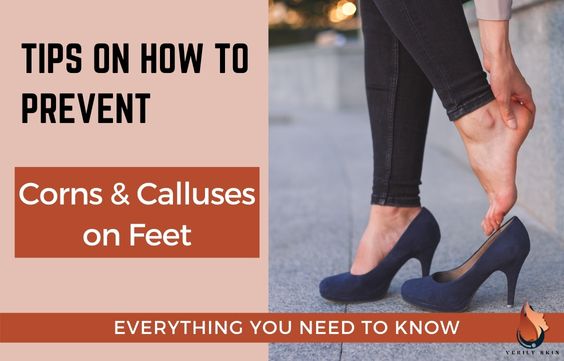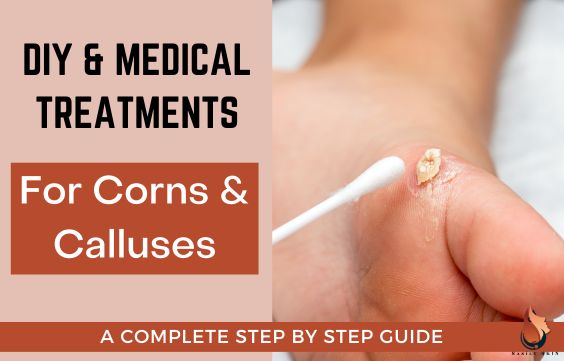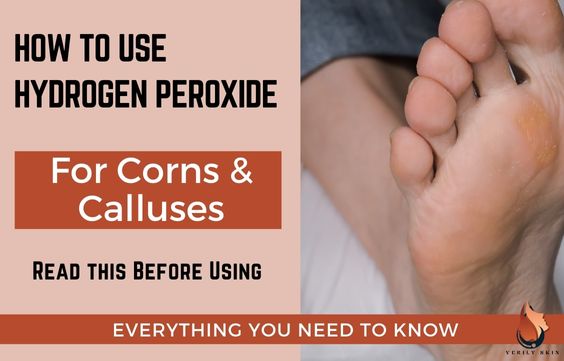How Long Calluses & Corns Last & Do They Go Away Naturally
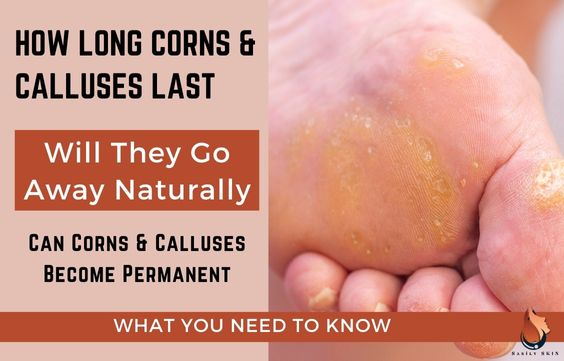
Calluses & Corns form on the feet and toes or the hands and fingers as the skin tries to protect itself from pressure and/or friction.
They form when the layers of skin thicken and harden over the affected area.
However, the major concerns we hear are how long calluses & corns last, and whether they go away naturally or need to be treated.
How Long Calluses & Corns Last On Hands & Feet
Calluses & corn can last for a very long time on your hands and feet if not treated.
How long your calluses and/or corns will last will depend on what is causing them and what you are doing to manage them.
If you do not have other complications like diabetes, structural deformities, or skin conditions that warrant treatment of your calluses and corns, then they will most likely not bother you as long as they do not get worse.
However, if you do have complications, especially diabetes or other medical conditions, you should seek medical treatment for your calluses and corns.
If they are painful or prevent you from using your hands and feet properly, then you should get them treated. You should also avoid the things that caused them in the first place to prevent them from reoccurring.
You need to read my article on Quick Remedies & Medical Treatments for Corns & Calluses
Related Article – Corns vs Calluses – What are the Differences & Types
Will Calluses & Corns Go Away Naturally
For some people, their calluses and/or corns will naturally resolve if they remove or avoid what is causing them.
The most common causes are friction, pressure, and irritation.
On the feet, this is most often due to ill-fitting shoes or from being on your feet a lot (especially if you are overweight).
On the hands, they are most often caused by friction like on the fingertips of guitar players, or the hands of craftsmen, weightlifters, and gymnasts.
If you are not in pain, and you do not have complications, then simply avoiding friction, pressure, and irritation of the area will prevent them from getting worse. Over time, they will eventually go away.
Related Article – 7 Tips on How to Prevent Calluses & Corns on Your Feet
What Happens If You Do Not Treat Calluses & Corns
If you continue to expose the callus and/or corn to friction, pressure, and irritation, they will get worse and may eventually develop complications.
Until you address the root issue that led to the development of the corns and calluses in the first place, untreated (or inadequately treated) corns and calluses may get bigger.
Infection is quite possible, especially if you are diabetic. Walking may become uncomfortable and challenging. You could require medical care or possibly surgery.
However, do not attempt to self-treat corns and calluses if you have diabetes, heart disease, or circulatory issues. These conditions may exacerbate foot issues. Consult a foot expert or your general practitioner.
Possible Treatment for corns and calluses:
Hydrogen Peroxide for Corns & Calluses: How to Safely Use
Apple Cider Vinegar For Corns & Calluses – What To Know
Salicylic Acid for Calluses & Corns: What You Need to Know
Can A Callus Be Permanent
A callus can live on your hands or feet rent-free for quite a long time unless they get worse or more painful.
Many people have calluses for years before they decide to do something about them, especially if they do not hurt or restrict activity in any way.
If they do get worse and begin to cause problems, you should get them treated. Otherwise, if you have no medical conditions or complications that will affect the callus or that can be affected by the callus, and if it does not bother you or is not getting worse, you do not need to have it aggressively treated.
Related Articles –
Tips on How to Prevent Calluses on Your Hands
Infected Corns & Calluses – How To Spot & Treat
Can A Corn Be Permanent
A corn cannot be permanent. Corns usually get progressively worse and will need to be treated.
Corns usually form over joints (like the toe or finger joints) and as they get worse (deeper) they begin to affect movement. They even become painful. Corns are also more likely to develop an infection or progress into an abscess.
It is recommended that you have your corns treated and do what you can to prevent them from reoccurring.
Related Article – Why Do Corns & Calluses Hurt & Easy Tips to Ease the Pain
Things To Keep In Mind
Keep in mind that calluses are different from corns.
Calluses often form on pressure points like the heels, balls of the feet, palms, and knees. They rarely cause pain. However, they are usually bigger than Corns and can be of different sizes and shapes.
On the other hand, Corns are smaller and deeper and feature a hard center surrounded by swollen skin. Pressing them might cause pain.
On the tops of the toes or the outside edge of the tiny toe are the common areas for hard corns to frequently develop. However, soft corns frequently develop between the toes.
Professional Treatment Of Calluses & Corns
Calluses and Corns are best treated by gentle debridement and avoidance of the root causes.
A callus or corn may be readily removed by a podiatrist. They will remove the thicker skin. However, unless you treat the underlying problem, it will keep coming back every 4 to 8 weeks.
Your podiatrist may also give or suggest some of the following treatments in addition to debridement:
- A foot balm or lotion for moisturizing and nourishing the skin of the feet and/or hands. This is similar to a moisturizer, but with the addition of urea, which significantly boosts efficiency.
- Applying a pumice stone to the calloused regions very carefully is important to avoid irritating the nearby skin.
- Salicylic Acid which helps soften and remove some of the layers of the skin.
- Cortisone injections to help with pain
- Surgery. In some cases, certain areas of your foot may be unduly stressed if a bone or joint is misaligned. Severe corns and calluses may result from this. Surgery may be the most effective solution in certain situations to solve the issue.
Afterward, they will recommend that you relieve the areas of high pressure or friction by:
- Using appropriate footwear that fit your feet correctly.
- Insoles that are specifically designed and recommended can relieve pressure from bony prominences and promote proper foot function.
- Ankle and foot strapping and/or hand strapping.
- A routine of exercises to increase strength, flexibility, and mobility to promote proper foot and/or hand function.
- Giving your hands a break from the work that is causing the callus or corn to form
Did you know you can use certain essential oils to treat corns and calluses check my article on: Best Essential Oils & Body Oils to Treat Corns & Calluses
Debriding and Managing Calluses & Corns At Home
Dermatologists advise using the following steps to manage corns and calluses at home:
- In warm water, soak the corn or callus. Do this for 5-10 minutes, or until the skin begins to soften.
- Use a pumice stone to smooth the corn or callus. Gently file the corn or callus after first dipping it in warm water. To remove dead skin, move your hands in a circular or lateral motion.
- Don’t remove too much skin at once. This could result in bleeding and infection. Do not do this at all if you are diabetic, have heart problems, or have circulation problems.
- Every day, apply a moisturizing cream to the region. Look for a moisturizing cream or lotion that contains urea, ammonium lactate, or salicylic acid. Hard corns and calluses can be progressively loosened with the use of these chemicals.
Related Article – 7 Tips on How to Prevent Calluses & Corns on Your Feet
- Apply a cushion. Cut a piece of moleskin, which is available at your local drugstore, into two half-moon shapes, and apply it around the callus. This prevents further aggravation when engaging in physical activity. Or, you can apply adhesive pads in the form of donuts on the corn to prevent it from touching your shoe. You may find them at drugstores.
- Avoid exposing your feet or hands to further pressure, friction or irritation.
Video: How to treat corns and calluses
Sources:
How to treat corns and calluses
What can you do if you have a corn? – InformedHealth.org – NCBI Bookshelf

